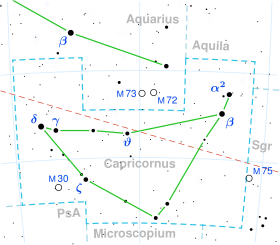염소자리 피
Phi Capricorni| 관찰 데이터 Epoch J2000.0EquinoxJ2000.0(ICRS) | |
|---|---|
| 콘스텔레이션 | 염소자리 |
| 적경 | 21h 15m 37.89982s[1] |
| 적위 | -20° 39° 06.1032°[1] |
| 겉보기 등급(V) | +5.16[2] |
| 특성. | |
| 스펙트럼형 | K0 II-III[3] |
| B-V 색지수 | +1.15[2] |
| 아스트로메트리 | |
| 반지름 속도(Rv) | - 4.5±0[4].5km/s |
| 고유운동(μ) | RA: +15.01[1] mas/년 Dec.: - 2.07[1] mas/년 |
| 시차()) | 5.07 ± 0.25 mas[1] |
| 거리 | 640 ± 30 ly (표준 ± 10 pc) |
| 절대 등급(MV) | - 1.16±0.199[5] |
| 세부 사항 | |
| 덩어리 | 2.63[6] M☉ |
| 광도 | 447[6] L☉ |
| 표면 중력(log g) | 1.77kg[5] |
| 온도 | 4,490±25[6] K |
| 금속성 [Fe/H] | - 0.15덱스[5] |
| 회전 속도(v sin i) | 3.8[7] km/s |
| 나이 | 1.24년식[6] |
| 기타 명칭 | |
| 데이터베이스 참조 | |
| 심바디 | 데이터. |
염소자리 파이(Phi Calforni)는 남쪽 염소자리에 있는 별이다[9].겉보기 등급은 +5.[2]16으로 육안으로 볼 수 있다.지구에서 [1]볼 때 연간 5.07밀리초의 시차 편이를 바탕으로 이 별은 태양으로부터 약 640광년 떨어진 곳에 있으며, 대략 30광년 정도 걸립니다.
이 별은 진화된 주황색 빛을 띤 K형 거성/밝은 거성으로, 분광형은 K0[3] II-III로, 질량 손실 사건에서 [7]남은 물질 때문일 수 있습니다.이 별의 질량은 태양의 [6]약 2.63배이며, 유효 온도 4,490 [6]K의 광구에서 태양 광도의 447배를 방출한다.피 염소자리는 약 12억[6] 4천만 년 된 것으로 추정 회전 속도 3.8 km/[7]s로 회전하고 있습니다.
한자이름
중국어로 12개국을 뜻하는 샤이어궈는 춘추전국시대 고대 12개국을 나타내는 별자리로, ①염소자리, ②염소자리, 38염소자리, 35염소자리, 36염소자리, ②염소자리, ③염소자리, ③염소자리, ③염소자리, ③염소자리, ③염소자리, ③염소자리, ③염소자리, ③염소자리, ③염소자리, ③, ③, ③염소자리, ③염소자리, ③, ③염소자리, 춘추전국시대, 춘추전국i, 26 염소자리, 27 염소자리, 20 염소자리, i 염소자리, 21 염소자리.[10]그 결과, 【염소자리】의 중국어 명칭 자체는 【[11]오피우치】와 함께 【천상시장 오른쪽 벽】의 【오피우치】[12][13]와 함께 【주】를 나타내고 있다.
R. H. Allen은 【Calforni】와 함께 【Calforni】는 【[13]Calforni】와 함께 【Wei】주(州)를 대표한다고 생각했다.
레퍼런스
- ^ a b c d e f van Leeuwen, F. (2007), "Validation of the new Hipparcos reduction", Astronomy and Astrophysics, 474 (2): 653–664, arXiv:0708.1752, Bibcode:2007A&A...474..653V, doi:10.1051/0004-6361:20078357, S2CID 18759600.
- ^ a b c Corben, P. M.; Stoy, R. H. (1968), "Photoelectric Magnitudes and Colours for Bright Southern Stars", Monthly Notes of the Astronomical Society of Southern Africa, 27: 11, Bibcode:1968MNSSA..27...11C.
- ^ a b Houk, N.; Smith-Moore, M. (1988), Michigan Catalogue of Two-dimensional Spectral Types for the HD Stars, vol. 4, Bibcode:1988mcts.book.....H.
- ^ Gontcharov, G. A. (November 2006), "Pulkovo Compilation of Radial Velocities for 35495 Hipparcos stars in a common system", Astronomy Letters, 32 (11): 759–771, arXiv:1606.08053, Bibcode:2006AstL...32..759G, doi:10.1134/S1063773706110065, S2CID 119231169.
- ^ a b c Park, Sunkyung; et al. (2013), "Wilson-Bappu Effect: Extended to Surface Gravity", The Astronomical Journal, 146 (4): 73, arXiv:1307.0592, Bibcode:2013AJ....146...73P, doi:10.1088/0004-6256/146/4/73, S2CID 119187733.
- ^ a b c d e f g Luck, R. Earle (2015), "Abundances in the Local Region. I. G and K Giants", Astronomical Journal, 150 (3), 88, arXiv:1507.01466, Bibcode:2015AJ....150...88L, doi:10.1088/0004-6256/150/3/88, S2CID 118505114.
- ^ a b c Fekel, Francis C.; Watson, Lyndon C. (November 1998), "A Search for Lithium-Rich Giants among Stars with Infrared Excesses", The Astronomical Journal, 116 (5): 2466–2474, Bibcode:1998AJ....116.2466F, doi:10.1086/300614.
- ^ "phi Cap", SIMBAD, Centre de données astronomiques de Strasbourg, retrieved 2017-05-10.
- ^ Eggleton, P. P.; Tokovinin, A. A. (September 2008), "A catalogue of multiplicity among bright stellar systems", Monthly Notices of the Royal Astronomical Society, 389 (2): 869–879, arXiv:0806.2878, Bibcode:2008MNRAS.389..869E, doi:10.1111/j.1365-2966.2008.13596.x, S2CID 14878976.
- ^ (in Chinese) 中國星座神話, written by 陳久金.2005년 발행, ISBN 978-986-7332-25-7.
- ^ (중국어) AEEA (천문학 전시회 및 교육 활동)2006년 7월 4일
- ^ (중국어) AEEA (천문학 전시 및 교육 활동)2006년 6월 24일
- ^ a b Allen, Richard Hinckley (1963), "Capricornus", Star Names, Their Lore and Meaning, Dover, retrieved 2017-05-09.


